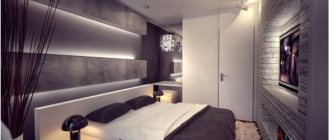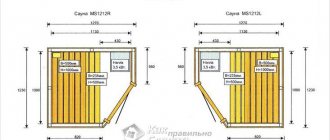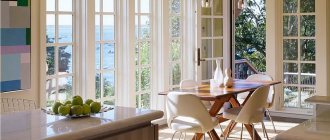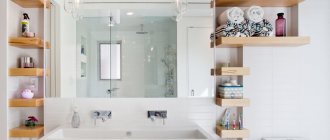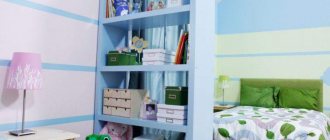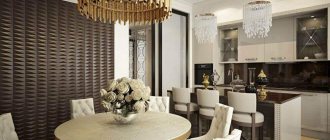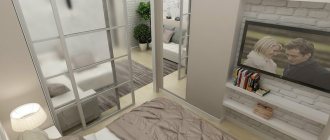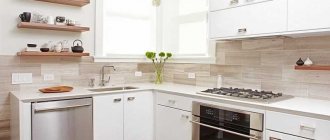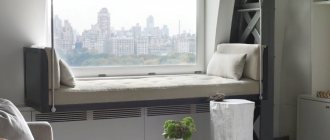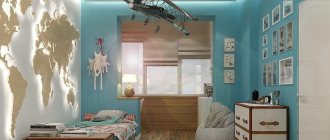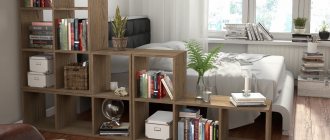Types of screens, options
Screens can be decorative, which decorate the interior, or commercial, which serve only to limit space. Designs also differ in the degree of light transmission; this factor depends on the material of the sashes.
Screen classification:
- With doors. The history of dividing space into zones using a screen began with this model. The partition consists of a dense frame and several doors. It may have different heights of legs or be without them at all. It works on the accordion principle. The first Chinese screens stretched along the entire room, turning one large area into two smaller ones (they had 8-10 doors). Screens decorated ancient houses and castles. In the 21st century, more compact designs are used that do not eat up space. The number of doors depends on the scale of the room. A standard screen has the following dimensions: height - 1.5-2 meters, width of the doors - 40-60 cm. The doors are attached to each other using piano hinges, furniture hinges. Advantages of the folding composition: stability, aesthetics, compactness (the screen can be folded). Often, casement structures are used to decorate interiors in modern, aristocratic and retro styles. The doors can be made of any material that suits the design of the room: paper, wood, carved panels, glass sheets, forged grilles, artistically painted fabric.
The doors fold easily, even in an unusual design. Source stroy-podskazka.ru
The doors of structures can have different sizes Source stroy-podskazka.ru
- Screen. They consist of a rigid base and one canvas made of textiles, plastic, and metal. The base of the structure is often rectangular, but if you want more originality, you can find round and soft models. Offers interesting variations. There are screens that are attached to the ceiling surface (suspended structures). This type includes screen curtains, which are attached to the wall or ceiling using a device that resembles a cornice in structure. The screen structure consists of one section, which does not fold, unlike the casement model. For stability, the screens are equipped with a bracket-like support (with or without wheels) or legs with massive heels. Single-screen screens can be connected to each other, but only certain models. Offers several options. The design is often used not only in home interiors, but also in offices, cafes, clinics, and salons.
The screen screen can be connected to more conveniently limit the space Source prorab.help
A decorative screen screen will decorate any interior Source tekstilprofi.com
- Flexible. The design is lighter compared to previous types. Elastic materials are used for the canvases, which quickly take on a given shape. The screen consists of several narrow, rigid strips onto which the material is attached. The structure is assembled into a roll, as unnecessary. The flexible screen is distinguished by its unusual appearance, emphasizing the sophistication of the interior and the excellent taste of the owner. Such a design in a home or cafe will never go unnoticed. The screen canvas is represented by one light wall (elastic strips connected to each other), in which there are no sashes. The flexible model allows you to adjust the length of the zonal overlap and create interesting labyrinths. Advantages of the design: innovative decorative item, unique design, ease of use, compact size, can take any shape. The screen does not hide the space and gives the room style and freedom. Light, plastic models look especially good. The design is often used in modern interiors: modern, techno, hi-tech, minimalism.
A flexible screen can take any shape Source legkovmeste.ru
The black, flexible screen looks stylish and modern Source stroy-podskazka.ru
- Sliding door partitions. The screen can replace a door and is mounted in the doorway. This design is chosen for Japanese-style interiors or small apartments, where every centimeter of space counts. Swinging doors take up a lot of space compared to a sliding partition. The sliding mechanism, frame and fittings are sold complete with the door leaf. To move the partition, special locks, guides, and stoppers are used. The size of the sliding screen depends on the doorway. Often such designs are made upon pre-order.
A sliding partition decorates the room and does not take up space Source dekoriko.ru
Using an accordion door you can create an additional room Source www.vsd-plus.com.ua
- Functional. This group includes casement and screen models. In addition to their decorative and zoning role, screens also carry a functional load. A screen rack with shelves or hangers for clothes, a design with an installed mirror, several pockets for books and magazines, and photo frames look original. Some designers manage to mount a small TV into the screen.
A screen with cells increases the functionality of the design Source stroy-podskazka.ru
Anything can be stored on the shelves of the screen. Source www.pinterest.com
The purpose of choosing a screen and the functionality of the room in which the structure will be located will help you choose a screen. For a house or apartment, it is better to take a folding or flexible one; they are easily transformed, change the space, and decorate the room. Screen screens are indispensable for commercial establishments.
Family photographs will decorate the interior and add originality to the screen Source stroy-podskazka.ru
The screen can only have a decorative function Source stroy-podskazka.ru
Advantages and disadvantages
A partition for commercial organizations can delimit tables in a cafe, dental chairs in a large clinic, or desks for managers of a large company. Structures should be easy to maintain and durable. During the working day, the sashes quickly become dirty.
A decorative screen can be placed in the director’s office Source www.ural.org
A modern partition in a house can be used not only as a space limiter, but also as an independent piece of furniture. A mirror screen can be placed in the corner near the bed, and a functional partition with shelves for books can be placed in the corner of the reading area.
An additional mirror in the bedroom will not hurt Source roomplan.ru
Design advantages:
- easy installation;
- a wide range, there are different models in style and design, among which there is definitely a composition suitable for the interior;
- small size, when folded the screen will easily fit into a pantry or closet;
- quick change of room decor, the structure can be moved or removed as unnecessary;
- original interior decor;
- dividing space into zones;
- low price compared to a plasterboard partition;
- creating a private corner in the room, protecting you from the general hustle and bustle;
- behind the screen hides everything that you don’t want to put on public display;
- mirror or glossy design increases space.
Videos
What else is new and interesting in the world of screens? I picked up a couple of videos that will add a little to what has already been said.
And with this view you can just sit back and admire the beautiful screens in the interior.
Surely, before reading this article, you had no idea how many types of screens there are and what their features are. Choosing a screen is not such a simple matter. In order not to regret later about a useless purchase, take into account all the circumstances. Make a list of the necessary “qualities” of a screen in terms of material, design and functionality and determine which screen will be ideal for you. Then the trick is to buy what you need. We hope that our article helped you and answered all your questions about screens and their purpose.
And you?
Flaws:
- a screen of a certain size may not fit in a small apartment, in which case it is better to order a design according to an individual drawing;
- does not have heat-insulating and sound-insulating properties, it creates only a psychological limitation of space.
A transparent design will add space and lightness to the room Source stroy-podskazka.ru
With skillful hands, you can create a screen with a fabric canvas yourself. Some interpretations of partitions have a removable canvas. Textiles can be easily washed when dirty.
The fabric on the doors can be with any pattern you like Source fototapete3d.md
Examples in interiors
The screen can be placed in any room: bathroom, living room, nursery, bedroom, kitchen. Where to place the structure depends on the layout of the apartment and the interior:
- In the bedroom, a screen can create an intimate sleeping area, cover a window or a dressing table with a mirror.
- In a large living room with a closet, the structure will designate a private dressing area.
- In the children's room it forms a secluded corner for studying and separates the desk from the play area. When there are no distractions, it is easier to concentrate on lessons.
- The design will help organize your office. It is enough to place the desktop behind the screen, then nothing will interfere with concentration.
- The large living room can be divided into a relaxation area and an area for receiving guests.
- A dividing structure will limit zones in a one-room apartment. Will create corners of privacy for all family members.
- In the kitchen-dining room, a partition will separate the area with the dining table. If you add additional lighting in the form of sconces, you will get a romantic and cozy atmosphere.
- In the bathroom, a screen protects from splashes and views. Partitions are used especially often when the bathroom is combined with a bathroom.
The screen serves as curtains in the bathroom of a country house Source roomplan.ru
History of decorative partitions in the interior
As is commonly believed, the country that invented the screen on wheels was China. Then this item carried not so much a decorative load, but served as a talisman for the bedroom and home from evil spirits. Decorative partitions in China were made of silk, decorated in every possible way with stones, beads and shells.
After screens became established in the land of the rising sun, the fashion for them migrated to Japan, where screens for partitions were made from paper and painted with national designs, for example, dragons and tigers.
Screens:
- Ancient type of construction;
- Have not changed to this day;
- They are a base, a starting point, for other decor configurations.
Only in the 17th century did screens begin to “come” to European homes, this happened for the reason that it became very popular and fashionable to decorate the interior of a house with elements of oriental cultures; accordingly, in Europe, partitions did not carry any semantic load, but served only as a trendy decor.
In the 18th century, Napoleon figured out how to use this piece in a more practical way, as decorative furniture, creating the prototype of the modern wardrobe.
By the 19th century, the fashion for screens reached Russia, but in most cases, it was not only decoration, they served as a partition in rooms that were rented out.

